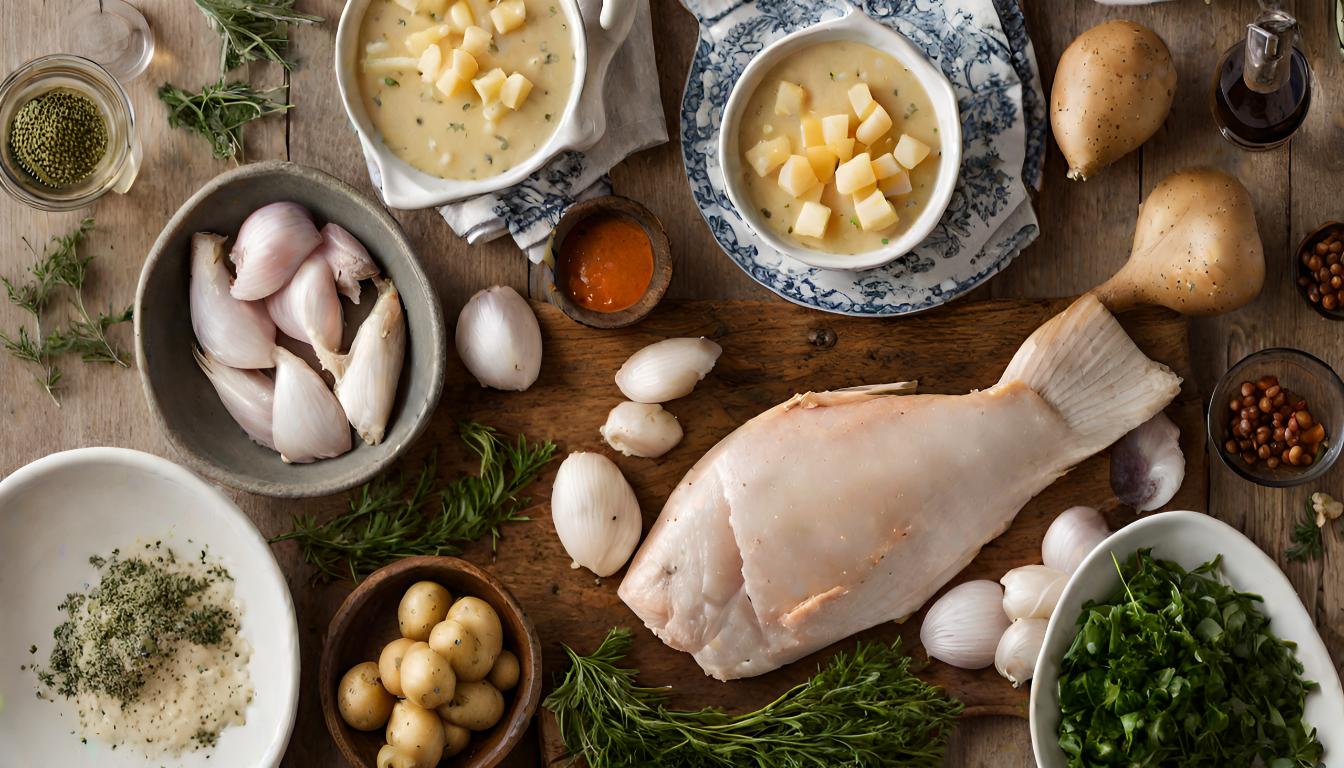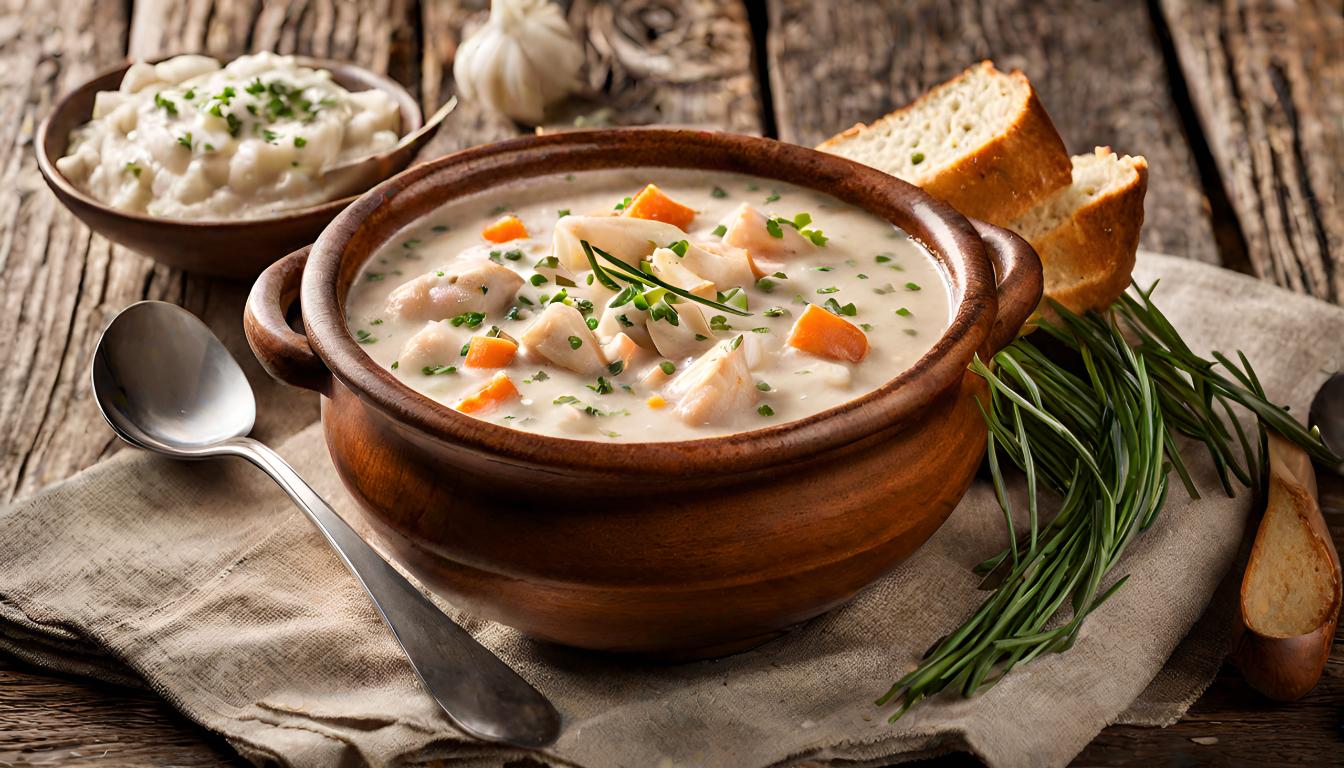Fish chowder, a creamy and comforting delight, has long warmed the hearts and bellies of many, especially in the chilly climates of New England. This dish, rich in history and flavor, is a testament to the simplicity and elegance of coastal cuisine. In this article, we’ll dive deep into the world of fish chowder, exploring everything from its humble beginnings to the various ways you can tailor it to your taste. Whether you’re a seasoned chowder enthusiast or a curious newcomer, this guide promises to equip you with all you need to craft the perfect bowl of chowder. So, let’s set sail on this culinary journey, shall we?
Introduction to Fish Chowder Recipe
Introduction to Fish Chowder
Fish chowder, a staple in New England cuisine, is more than just a soup; it’s a piece of history served in a bowl. Originating from the fishing communities that dot the Northeastern United States, this dish has evolved but always remained true to its roots: simple, hearty, and utterly delicious. The traditional fish chowder recipe, a creamy concoction of fish, potatoes, and onions, has been passed down through generations, each adding their own twist but never straying far from its original essence.
Brief History and Regional Variations
The journey of fish chowder began with the Native Americans, who first introduced this method of cooking to European settlers. The settlers adapted it, incorporating ingredients readily available to them, such as dairy and salted pork. As the recipe traveled, regional variations emerged. For instance, the Manhattan chowder, with its tomato base, offers a tangy twist, while the Rhode Island chowder presents a clear broth alternative, showcasing the versatility of this beloved dish.
Importance of Fish Chowder in New England Cuisine
In New England, fish chowder is more than just food; it’s a cultural icon. It embodies the resourcefulness and resilience of the region’s people. From family gatherings to community events, fish chowder has a way of bringing people together, offering comfort and warmth against the backdrop of the harsh New England winters. It’s a dish that tells stories, a dish that, despite its simplicity, is layered with flavors and history.
In the next sections, we’ll delve into the essential ingredients that make up this iconic dish, explore the step-by-step process of bringing it to life, and share tips and tricks to ensure your chowder is nothing short of spectacular. So, grab your spoon, and let’s get ready to enjoy a bowl of fish chowder that’s as rich in taste as it is in tradition.
Related link: Basmati Rice: Cooking Tips for Fluffy and Fragrant Grains.
Essential Ingredients and Substitutions
Creating a mouthwatering fish chowder begins with understanding the core ingredients that define its classic taste and texture. While tradition dictates a specific set of ingredients, the beauty of chowder lies in its adaptability. Let’s explore the foundational components and how you can tweak them to suit your palate or pantry.
Main Ingredients
- Cod or Alternative Whitefish: The star of the show is undoubtedly the fish. Cod, with its mild flavor and flaky texture, is the traditional choice. However, the ocean is your oyster when it comes to alternatives. Tilapia, haddock, snapper, and monkfish are excellent substitutes, each bringing its unique taste to the bowl. The key is to choose a fish that’s hearty enough to stand up to simmering without falling apart.
- Potatoes, Onions, and Clam Juice: These ingredients form the backbone of your chowder, providing depth and body. Potatoes add heartiness, while onions offer a subtle sweetness that complements the fish perfectly. Clam juice, a secret weapon in many chowder recipes, infuses the broth with a briny depth that water or stock alone can’t achieve. If clam juice isn’t your cup of tea or hard to come by, fear not; a combination of water and a pinch of sea salt can work wonders.
Substitutions
- Dairy Alternatives for Milk and Cream: Traditional chowder gets its creamy consistency from whole milk and heavy cream. If you’re looking to lighten things up or cater to dietary restrictions, half-and-half, or even a plant-based milk like almond or oat, can be used. The trick is to add these alternatives slowly and adjust the heat to avoid curdling.
- Herb and Spice Variations: Thyme, bay leaves, and a dash of nutmeg give chowder its signature flavor profile. However, the world of herbs and spices is vast. Feel free to experiment with dill, parsley, or even a pinch of smoked paprika for a hint of warmth. Remember, the goal is to enhance, not overpower, the delicate flavors of the fish and vegetables.
In crafting your fish chowder, remember that each ingredient, whether a mainstay or a substitution, plays a role in weaving the rich tapestry of flavors that this dish is known for. By understanding the function and potential alternatives for each component, you’re not just following a recipe; you’re engaging in a culinary tradition that’s as fluid as the sea itself. So, whether you stick to the classics or venture into new waters with substitutions, the perfect bowl of chowder awaits.
Step-by-Step Cooking Process
Mastering the art of making fish chowder is akin to conducting an orchestra: each ingredient must enter the pot at just the right moment and blend harmoniously with the others. Follow these steps to ensure your chowder sings with flavor.
related link : Chicken Chips: Delicious Recipes, Nutritional Benefits & More.
Preparation of Ingredients
- Prepping Fish and Vegetables: Begin by preparing your fish. If using cod or a similar whitefish, cut it into manageable pieces that will fit nicely on a spoon. Next, tackle the vegetables. Dice your potatoes into uniform pieces to ensure even cooking, and finely chop your onions to release their sweet flavors. This prep work is essential for a chowder where every spoonful is a perfect balance of ingredients.
Cooking Method
-
Sautéing: In a large pot, melt butter with a splash of olive oil over medium heat. Add your chopped onions and cook until they’re translucent but not browned. This step is crucial for building the chowder’s base flavor. The onions should sweat and soften, becoming the aromatic backbone of your dish.
-
Poaching Fish: Once the onions are ready, add water (or a mix of water and clam juice) to the pot, along with bay leaves, thyme, salt, and pepper. Bring the mixture to a gentle boil before adding your fish pieces. Poach the fish until it flakes easily with a fork but remains intact. This gentle cooking method ensures the fish retains its moisture and delicate texture.
-
Simmering Chowder: After removing the fish, add the diced potatoes to the pot and simmer until tender. Meanwhile, in a separate pot, scald the milk by heating it just below boiling point with a quartered onion. This process infuses the milk with a subtle onion flavor and prevents the dairy from curdling when added to the chowder.
-
Combining Ingredients: With the potatoes cooked, strain the scalded milk into the main pot, discarding the onion. Gently fold the flaked fish back into the pot, allowing it to warm through without breaking apart. The chowder should be thick enough to coat the back of a spoon but still pourable.
-
Finishing Touches: Finally, stir in the heavy cream and adjust the seasoning with salt and pepper to taste. Add a pinch of ground nutmeg and some fresh chives for an extra layer of flavor. Serve the chowder hot, with a sprinkle of chives and a dash of black pepper on top for garnish.
external link: https://www.mayoclinic.org/diseases-conditions/heart-disease/in-depth/omega-3/art-20045614
Creating a fish chowder that’s rich, comforting, and bursting with flavor is all about patience and attention to detail. By following these steps, you’ll not only cook a delicious meal but also partake in a culinary tradition that has brought warmth and satisfaction to countless tables. Enjoy the process, and soon you’ll be dishing out bowls of chowder that are sure to impress.
Tips and Tricks for Perfect Fish Chowder Recipe
Crafting the perfect bowl of fish chowder is an art form that comes with its own set of nuances. To elevate your chowder from good to great, consider these tips and tricks that focus on enhancing flavor, texture, and overall appeal.
Cooking Tips
- Achieving the Perfect Texture: The texture of your chowder is paramount. For a thicker consistency, consider mashing a portion of the cooked potatoes directly in the pot. This natural thickener integrates seamlessly, adding body without diluting the chowder’s rich flavor. If your chowder is too thick, a splash of milk can help thin it to your desired consistency. Remember, the chowder will continue to thicken as it cools, so aim for a slightly looser consistency than your final goal.
- Layering Flavors: Building depth of flavor in your chowder is a gradual process. Sautéing onions until they’re just translucent releases their natural sugars, providing a sweet foundation. The choice of herbs, such as thyme and bay leaves, infuses the broth with aromatic complexity. Don’t rush these steps; allowing each ingredient to contribute its full potential will result in a chowder that’s rich and satisfying.
Serving Suggestions
- Accompaniments and Garnishes: A bowl of fish chowder is a complete meal in itself, but the right accompaniments can turn it into a feast. Serve your chowder with a side of crusty bread or oyster crackers for dipping and added texture. For garnishes, a sprinkle of fresh herbs like parsley or chives adds a pop of color and freshness. A light drizzle of good quality olive oil or a few drops of hot sauce can also enhance the chowder’s flavor profile, catering to individual tastes.
- Pairing with Beverages: When it comes to pairing your chowder with beverages, consider the richness of the dish. A crisp, acidic white wine, such as a Sauvignon Blanc or a Chardonnay, can cut through the creaminess and refresh the palate. For non-alcoholic options, sparkling water with a squeeze of lemon offers a similar brightness.
By keeping these tips in mind, you’re well on your way to creating a fish chowder that not only warms the soul but also delights the senses. Remember, the best chowder is one made with care and attention to detail, allowing each ingredient to shine. So, don your chef’s hat, and let’s make a chowder that’ll be remembered long after the last spoonful is savored.
FAQs about Fish Chowder Recipe
When it comes to making fish chowder, questions abound, especially for those new to this culinary delight. Here are answers to some frequently asked questions that might arise as you embark on your chowder-making journey.
Can I Use Frozen Fish?
Absolutely! Frozen fish can be a convenient and economical choice for your chowder. Just ensure it’s fully thawed and patted dry before adding it to the pot to prevent any excess water from diluting the chowder’s flavor. Remember, the key to a great chowder is the quality of the fish, so choose frozen options that are reputable for their freshness and quality.
How Can I Make My Chowder Thicker or Thinner?
The consistency of your chowder is largely a matter of personal preference. For a thicker chowder, a roux made from flour and butter can be added at the beginning of the cooking process. Alternatively, blending a portion of the chowder and stirring it back into the pot can also enhance its thickness. To thin a chowder, simply add more milk or fish stock until you reach your desired consistency. Adjusting the thickness allows you to customize the chowder to your liking, whether you prefer it hearty and substantial or lighter and more soup-like.
Can Fish Chowder Be Frozen and Reheated?
While you can freeze fish chowder, it’s important to note that the texture, especially of the dairy components, may change upon reheating. Cream-based soups can separate or become grainy when frozen and then thawed. If you plan to freeze your chowder, consider doing so before adding the milk and cream. When you’re ready to enjoy it, thaw the chowder, reheat gently, and then add fresh dairy to preserve the creamy texture.
Are There Any Vegetarian Alternatives?
For a vegetarian take on fish chowder, you can substitute the fish with hearty vegetables like cauliflower, mushrooms, or corn, which add a satisfying depth and texture to the dish. Vegetable broth can replace the clam juice, and a dash of seaweed or miso paste can impart a subtle umami flavor reminiscent of the sea. This versatility ensures that even those following a vegetarian diet can enjoy the comforting warmth of a homemade chowder.
Armed with these FAQs, you’re better prepared to tackle the making of fish chowder, adapting it to your tastes and dietary preferences. Remember, cooking is as much about improvisation and personalization as it is about following recipes. So, feel free to experiment and make the dish your own.
Nutritional Information and Health Benefits
Diving into a bowl of fish chowder is not just a treat for your taste buds but can also be a boon for your health. This section will highlight the nutritional benefits of the key ingredients in fish chowder, providing insights into how this comforting dish can fit into a balanced diet.
Health Benefits
- Fish: The centerpiece of the chowder, fish like cod, is a low-fat source of high-quality protein. It’s rich in essential nutrients, including omega-3 fatty acids, which are crucial for heart and brain health. Incorporating fish into your diet can contribute to cardiovascular health, improve joint mobility, and support mental well-being.
- Potatoes: Often unfairly maligned, potatoes are a good source of vitamins C and B6, potassium, and dietary fiber, especially when consumed with their skins. They provide energy through complex carbohydrates and can help maintain healthy blood pressure levels.
- Milk and Cream: While they add richness to the chowder, milk and cream also contribute calcium and vitamin D, essential for bone health. Opting for low-fat or plant-based alternatives can help manage calorie intake without sacrificing the creamy texture that defines the dish.
- Onions and Garlic: These aromatic ingredients are not just flavor enhancers; they’re also packed with antioxidants and have been linked to a host of health benefits, including reduced inflammation and improved heart health.
- Herbs and Spices: Thyme, bay leaves, and nutmeg not only add depth to the chowder’s flavor but also contain compounds with anti-inflammatory and antibacterial properties.
While fish chowder can be a hearty dish, its nutritional profile makes it a worthwhile addition to your culinary repertoire, especially when enjoyed as part of a balanced diet. By choosing high-quality ingredients and being mindful of portions, you can savor this comforting classic while nourishing your body.
In crafting your chowder, remember that each ingredient brings not just flavor but also nutritional benefits to the table. So, the next time you ladle out a serving of this creamy, comforting soup, know that you’re indulging in a dish that’s as good for you as it is delicious.
Final Thoughts about Fish Chowder Recipe
As our culinary journey through the world of fish chowder comes to a close, it’s clear that this dish is much more than a simple soup. It’s a testament to the power of simple ingredients coming together to create something truly comforting and nourishing. From the flaky tenderness of the fish to the creamy richness of the broth, each spoonful of chowder tells a story of tradition, innovation, and communal warmth.
In crafting your own version of fish chowder, remember that cooking is an act of creativity and personal expression. Whether you adhere to the traditional New England recipe or infuse the dish with your unique twist, the key is to cook with passion and intention. Embrace the process, from selecting the freshest ingredients to savoring the final product, and you’ll find that fish chowder can be a rewarding dish to make and share.
Moreover, the versatility of fish chowder allows it to cater to a wide range of dietary preferences and nutritional needs. Whether you’re seeking comfort on a cold day, a nutritious meal for your family, or simply the joy of cooking something delicious, fish chowder is a dish that delivers on all fronts.
Conclusion
fish chowder is more than just food; it’s a celebration of coastal cuisine, a nod to culinary tradition, and a canvas for personal expression. So, the next time you’re in the mood for something warm, creamy, and utterly satisfying, consider reaching for a pot and embarking on the delightful experience of making fish chowder. It’s a dish that promises to comfort, nourish, and inspire, one spoonful at a time.
Having journeyed through the intricacies of crafting the perfect fish chowder, from the foundational ingredients and substitutions to the detailed cooking process, and rounding off with the nutritional benefits, we’ve covered a comprehensive guide to this beloved dish. This exploration has not only highlighted the versatility and richness of fish chowder but also underscored its place within the realm of comforting, nutritious meals that speak to the heart of home cooking.
As we conclude, it’s evident that fish chowder is more than a mere recipe; it’s a canvas for culinary creativity, a vessel for nutrition, and a beacon of comfort food. It embodies the essence of what cooking is all about: bringing together simple ingredients to create something that nourishes both the body and soul. Whether you’re a seasoned chef or a novice in the kitchen, the journey of making fish chowder offers a rewarding experience, filled with the joy of cooking and the warmth of sharing a meal with loved ones.
In embracing fish chowder, you’re not just preparing a meal; you’re participating in a rich culinary tradition that spans generations and geographies. Each batch of chowder is a reflection of its maker, infused with personal touches and preferences that make it uniquely satisfying.








Comments are closed.